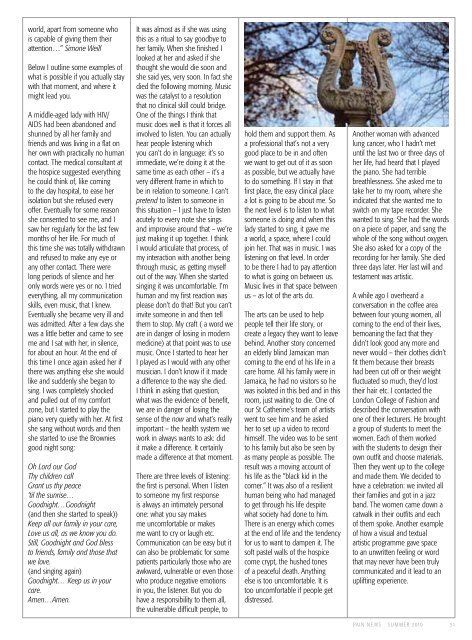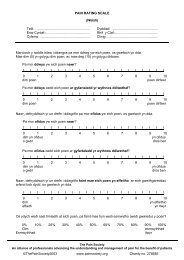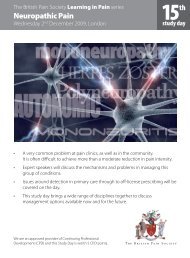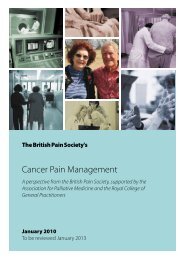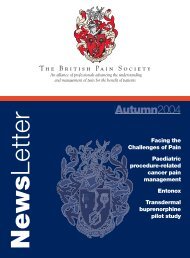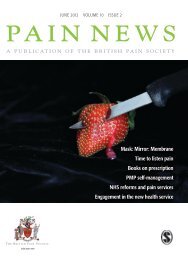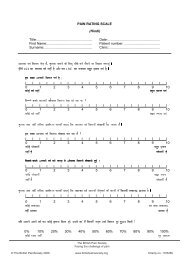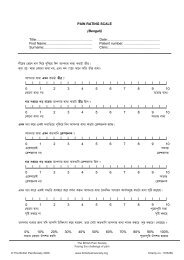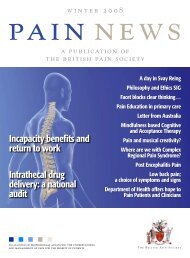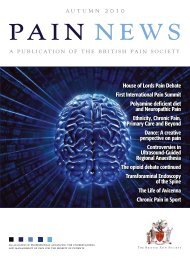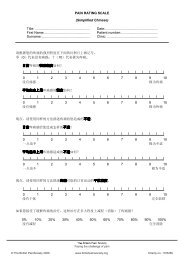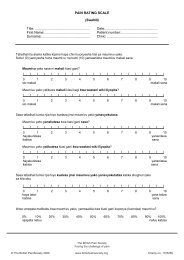Summer 2010 - The British Pain Society
Summer 2010 - The British Pain Society
Summer 2010 - The British Pain Society
Create successful ePaper yourself
Turn your PDF publications into a flip-book with our unique Google optimized e-Paper software.
world, apart from someone who<br />
is capable of giving them their<br />
attention…” Simone Weill<br />
Below I outline some examples of<br />
what is possible if you actually stay<br />
with that moment, and where it<br />
might lead you.<br />
A middle-aged lady with HIV/<br />
AIDS had been abandoned and<br />
shunned by all her family and<br />
friends and was living in a flat on<br />
her own with practically no human<br />
contact. <strong>The</strong> medical consultant at<br />
the hospice suggested everything<br />
he could think of, like coming<br />
to the day hospital, to ease her<br />
isolation but she refused every<br />
offer. Eventually for some reason<br />
she consented to see me, and I<br />
saw her regularly for the last few<br />
months of her life. For much of<br />
this time she was totally withdrawn<br />
and refused to make any eye or<br />
any other contact. <strong>The</strong>re were<br />
long periods of silence and her<br />
only words were yes or no. I tried<br />
everything, all my communication<br />
skills, even music, that I knew.<br />
Eventually she became very ill and<br />
was admitted. After a few days she<br />
was a little better and came to see<br />
me and I sat with her, in silence,<br />
for about an hour. At the end of<br />
this time I once again asked her if<br />
there was anything else she would<br />
like and suddenly she began to<br />
sing. I was completely shocked<br />
and pulled out of my comfort<br />
zone, but I started to play the<br />
piano very quietly with her. At first<br />
she sang without words and then<br />
she started to use the Brownies<br />
good night song:<br />
Oh Lord our God<br />
Thy children call<br />
Grant us thy peace<br />
‘til the sunrise…<br />
Goodnight…Goodnight<br />
(and then she started to speak))<br />
Keep all our family in your care,<br />
Love us all, as we know you do.<br />
Still, Goodnight and God bless<br />
to friends, family and those that<br />
we love.<br />
(and singing again)<br />
Goodnight… Keep us in your<br />
care.<br />
Amen…Amen.<br />
It was almost as if she was using<br />
this as a ritual to say goodbye to<br />
her family. When she finished I<br />
looked at her and asked if she<br />
thought she would die soon and<br />
she said yes, very soon. In fact she<br />
died the following morning. Music<br />
was the catalyst to a resolution<br />
that no clinical skill could bridge.<br />
One of the things I think that<br />
music does well is that it forces all<br />
involved to listen. You can actually<br />
hear people listening which<br />
you can’t do in language: it’s so<br />
immediate, we’re doing it at the<br />
same time as each other – it’s a<br />
very different frame in which to<br />
be in relation to someone. I can’t<br />
pretend to listen to someone in<br />
this situation – I just have to listen<br />
acutely to every note she sings<br />
and improvise around that – we’re<br />
just making it up together. I think<br />
I would articulate that process, of<br />
my interaction with another being<br />
through music, as getting myself<br />
out of the way. When she started<br />
singing it was uncomfortable. I’m<br />
human and my first reaction was<br />
please don’t do that! But you can’t<br />
invite someone in and then tell<br />
them to stop. My craft ( a word we<br />
are in danger of losing in modern<br />
medicine) at that point was to use<br />
music. Once I started to hear her<br />
I played as I would with any other<br />
musician. I don’t know if it made<br />
a difference to the way she died.<br />
I think in asking that question,<br />
what was the evidence of benefit,<br />
we are in danger of losing the<br />
sense of the now and what’s really<br />
important – the health system we<br />
work in always wants to ask: did<br />
it make a difference. It certainly<br />
made a difference at that moment.<br />
<strong>The</strong>re are three levels of listening:<br />
the first is personal. When I listen<br />
to someone my first response<br />
is always an intimately personal<br />
one: what you say makes<br />
me uncomfortable or makes<br />
me want to cry or laugh etc.<br />
Communication can be easy but it<br />
can also be problematic for some<br />
patients particularly those who are<br />
awkward, vulnerable or even those<br />
who produce negative emotions<br />
in you, the listener. But you do<br />
have a responsibility to them all,<br />
the vulnerable difficult people, to<br />
hold them and support them. As<br />
a professional that’s not a very<br />
good place to be in and often<br />
we want to get out of it as soon<br />
as possible, but we actually have<br />
to do something. If I stay in that<br />
first place, the easy clinical place<br />
a lot is going to be about me. So<br />
the next level is to listen to what<br />
someone is doing and when this<br />
lady started to sing, it gave me<br />
a world, a space, where I could<br />
join her. That was in music. I was<br />
listening on that level. In order<br />
to be there I had to pay attention<br />
to what is going on between us.<br />
Music lives in that space between<br />
us – as lot of the arts do.<br />
<strong>The</strong> arts can be used to help<br />
people tell their life story, or<br />
create a legacy they want to leave<br />
behind. Another story concerned<br />
an elderly blind Jamaican man<br />
coming to the end of his life in a<br />
care home. All his family were in<br />
Jamaica, he had no visitors so he<br />
was isolated in this bed and in this<br />
room, just waiting to die. One of<br />
our St Catherine’s team of artists<br />
went to see him and he asked<br />
her to set up a video to record<br />
himself. <strong>The</strong> video was to be sent<br />
to his family but also be seen by<br />
as many people as possible. <strong>The</strong><br />
result was a moving account of<br />
his life as the “black kid in the<br />
corner.” It was also of a resilient<br />
human being who had managed<br />
to get through his life despite<br />
what society had done to him.<br />
<strong>The</strong>re is an energy which comes<br />
at the end of life and the tendency<br />
for us to want to dampen it. <strong>The</strong><br />
soft pastel walls of the hospice<br />
come crypt, the hushed tones<br />
of a peaceful death. Anything<br />
else is too uncomfortable. It is<br />
too uncomfortable if people get<br />
distressed.<br />
Another woman with advanced<br />
lung cancer, who I hadn’t met<br />
until the last two or three days of<br />
her life, had heard that I played<br />
the piano. She had terrible<br />
breathlessness. She asked me to<br />
take her to my room, where she<br />
indicated that she wanted me to<br />
switch on my tape recorder. She<br />
wanted to sing. She had the words<br />
on a piece of paper, and sang the<br />
whole of the song without oxygen.<br />
She also asked for a copy of the<br />
recording for her family. She died<br />
three days later. Her last will and<br />
testament was artistic.<br />
A while ago I overheard a<br />
conversation in the coffee area<br />
between four young women, all<br />
coming to the end of their lives,<br />
bemoaning the fact that they<br />
didn’t look good any more and<br />
never would – their clothes didn’t<br />
fit them because their breasts<br />
had been cut off or their weight<br />
fluctuated so much, they’d lost<br />
their hair etc. I contacted the<br />
London College of Fashion and<br />
described the conversation with<br />
one of their lecturers. He brought<br />
a group of students to meet the<br />
women. Each of them worked<br />
with the students to design their<br />
own outfit and choose materials.<br />
<strong>The</strong>n they went up to the college<br />
and made them. We decided to<br />
have a celebration: we invited all<br />
their families and got in a jazz<br />
band. <strong>The</strong> women came down a<br />
catwalk in their outfits and each<br />
of them spoke. Another example<br />
of how a visual and textual<br />
artistic programme gave space<br />
to an unwritten feeling or word<br />
that may never have been truly<br />
communicated and it lead to an<br />
uplifting experience.<br />
PAI N N E W S S U M M E R <strong>2010</strong> 51


